The 2026 NBA draft is still nearly 10 months away, but a number of teams have already traded away their first-round picks for ’26, and more clubs may do so before this season’s trade deadline.
We’ll use the space below to keep tabs on each team’s first-round pick for 2026, continually updating it as necessary throughout the year.
We’ve listed all 30 teams here, so even if a team hasn’t traded its first-round pick, that will be noted. We’ll also provide details on the protections for each traded pick, including what happens to the pick in 2027 if it doesn’t change hands in 2026.
Here’s the full breakdown on the status of each 2026 first-round pick:
Note: Teams marked with an asterisk (*) have traded away their 2027 first-round pick (either unprotected or with protection) and can’t freely trade away their 2026 first-rounder due to the Stepien Rule.
Atlantic
- Boston Celtics: Own pick.
- Brooklyn Nets: Own pick.
- New York Knicks (*): Own pick.
- Philadelphia 76ers: Traded to Thunder (top-four protected).
- If this pick lands in its protected range, the Sixers would instead owe the Thunder their 2027 first-round pick (top-four protected).
- Toronto Raptors: Own pick.
Central
- Chicago Bulls: Own pick.
- Cleveland Cavaliers (*): Traded swap rights to Jazz and Hawks.
- Details outlined at bottom of article.
- Detroit Pistons: Own pick.
- Indiana Pacers: Own pick.
- Milwaukee Bucks (*): Traded swap rights to Hawks.
- The Hawks will receive the most favorable pick of the Bucks and Pelicans’ first-rounders; the Bucks will receive the least favorable of the two.
Southeast
- Atlanta Hawks (*): Traded swap rights to Spurs.
- Details outlined at bottom of article.
- Charlotte Hornets: Own pick.
- Miami Heat (*): Own pick.
- Orlando Magic: Traded to Grizzlies or Hornets.
- Details outlined at bottom of article.
- Washington Wizards: Traded to Knicks (top-eight protected).
- If this pick lands in its protected range, the Wizards would instead send the Knicks their 2026 second-round pick and 2027 second-round pick, and Washington would have swap rights on its pick (details outlined at bottom of article).
Northwest
- Denver Nuggets (*): Own pick.
- Minnesota Timberwolves (*): Traded swap rights to Jazz.
- Details outlined at bottom of article.
- Oklahoma City Thunder: Own pick.
- Portland Trail Blazers: Traded to Bulls (top-14 protected).
- If this pick lands in its protected range, the Trail Blazers would instead owe the Bulls their 2027 first-round pick (top-14 protected).
- Utah Jazz: Traded to Thunder (top-eight protected).
- If this pick lands in its protected range, the Jazz’s obligation to the Thunder would be extinguished and Utah would have swap rights on its pick (details outlined at bottom of article).
Pacific
- Golden State Warriors: Own pick.
- Los Angeles Clippers: Traded to Thunder or Wizards.
- The Thunder will receive the two most favorable picks of their own, the Rockets’ (top-four protected), and the Clippers’ first-rounders. The Wizards will receive the least favorable of the three.
- Los Angeles Lakers (*): Own pick.
- Phoenix Suns (*): Traded to Wizards, Grizzlies, or Hornets.
- Details outlined at bottom of article.
- Sacramento Kings: Own pick.
Southwest
- Dallas Mavericks (*): Own pick.
- Houston Rockets: Traded to Thunder or Wizards (top-four protected).
- The Thunder will receive the two most favorable picks of their own, the Rockets’ (top-four protected), and the Clippers’ first-rounders. The Wizards will receive the least favorable of the three.
- If this pick lands in its protected range, the Rockets would instead send the Thunder their 2026 second-round pick and Oklahoma City would only receive one of the above picks instead of two.
- Memphis Grizzlies: Own pick.
- The Grizzlies have swap rights on their pick. Details outlined at bottom of article.
- New Orleans Pelicans: Traded to Hawks or Bucks.
- The Hawks will receive the most favorable pick of the Bucks and Pelicans’ first-rounders; the Bucks will receive the least favorable of the two.
- San Antonio Spurs: Own pick.
- The Spurs have swap rights on their pick. Details outlined at bottom of article.
A series of 2026 first-round picks are tied up in a pair of convoluted trade/swap scenarios. The first of those situations involves the Spurs‘, Hawks‘, Jazz‘s, Timberwolves‘ and Cavaliers‘ first-rounders, while the second involves the Suns‘, Wizards‘, Magic‘s, and Grizzlies‘ picks.
Here are the details on how the first set of picks will be distributed:
The Spurs will receive the most favorable of the following picks:
- The Spurs’ own first-round pick.
- The Hawks’ first-round pick.
The Jazz will receive the most favorable of the following picks if their own first-rounder is in the top eight:
- The Jazz’s own first-round pick.
- The Timberwolves’ first-round pick.
- The Cavaliers’ first-round pick.
The Timberwolves will receive the least favorable of the following picks:
- The Timberwolves’ own first-round pick.
- The Jazz’s first-round pick (if in the top eight).
The Hawks will receive the most favorable of the following picks, while the Cavaliers will receive the least favorable:
- The least favorable of the Hawks’ own first-round pick and the Spurs’ first-round pick.
- The least favorable of the Cavaliers’ first-round pick and either the Jazz’s first-round pick (if in the top eight) and the Timberwolves’ first-round pick (whichever is most favorable).
If the Jazz’s pick lands outside the top eight, it will be sent to the Thunder, and the Timberwolves will keep their own first-round pick. In that scenario, the Jazz/Timberwolves picks would not be in play for the Hawks and Cavaliers — and Utah wouldn’t control a first-rounder.
Here are the details on how the second set of picks will be distributed:
The Wizards will receive the most favorable of the following picks if their own first-rounder is in the top eight:
- The Wizards’ own first-round pick.
- The Suns’ first-round pick.
The Grizzlies will receive the two most favorable of the following picks, while the Hornets will receive the least favorable:
- The Grizzlies’ own first-round pick.
- The Magic’s first-round pick.
- The least favorable of the Wizards’ first-round pick (if in the top eight) and the Suns’ first-round pick.
If the Wizards’ pick lands outside the top eight, it will be sent to the Knicks. In that scenario, the Wizards pick wouldn’t be in play for the Grizzlies and Hornets — and Washington wouldn’t control a first-rounder.
Information from RealGM was used in the creation of this post.

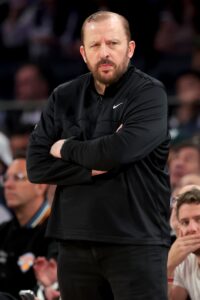 That doesn’t mean it was an uneventful offseason in New York though. The biggest change came on the sidelines, where head coach Tom Thibodeau was let go after five pretty impressive seasons with the team. Thibodeau was named Coach of the Year in 2021 and won playoff series in 2023, 2024, and 2025, leading the Knicks to 50-win seasons in each of the past two years.
That doesn’t mean it was an uneventful offseason in New York though. The biggest change came on the sidelines, where head coach Tom Thibodeau was let go after five pretty impressive seasons with the team. Thibodeau was named Coach of the Year in 2021 and won playoff series in 2023, 2024, and 2025, leading the Knicks to 50-win seasons in each of the past two years.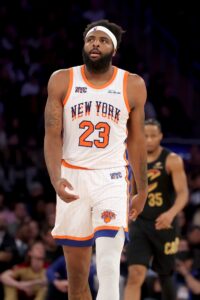 But even trading Dadiet without taking any salary back wouldn’t quite create enough cap flexibility for the Knicks to sign a veteran free agent to be their 14th man after they’ve filled the 12th and 13th roster spots. So unless a bigger deal is coming – perhaps one involving center
But even trading Dadiet without taking any salary back wouldn’t quite create enough cap flexibility for the Knicks to sign a veteran free agent to be their 14th man after they’ve filled the 12th and 13th roster spots. So unless a bigger deal is coming – perhaps one involving center 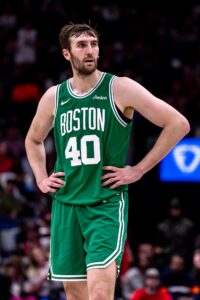
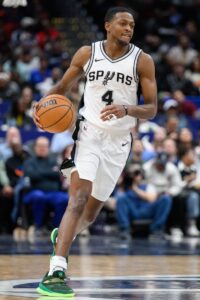 The first of the Spurs’ big breaks came in January, when
The first of the Spurs’ big breaks came in January, when  If San Antonio does intend to fill that roster spot before the season begins, it could make sense to add one more big man for depth purposes, given that Wembanyama is coming off a health scare and Olynyk isn’t exactly a true center. For what it’s worth, former Spur
If San Antonio does intend to fill that roster spot before the season begins, it could make sense to add one more big man for depth purposes, given that Wembanyama is coming off a health scare and Olynyk isn’t exactly a true center. For what it’s worth, former Spur 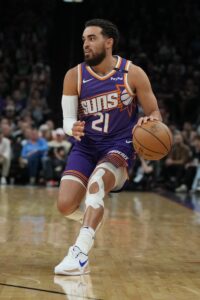
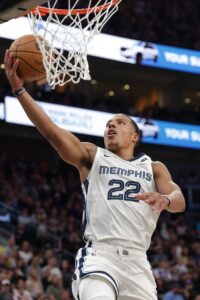 Even as the roster jelled and they returned to the playoffs during the past two seasons, three-point shooting remained an issue for the Magic. The team’s 31.8% success rate last season didn’t just rank dead last in the NBA — the gap between Orlando and 29th-place Washington was bigger than the gap between the third- and 17th-place teams in that category.
Even as the roster jelled and they returned to the playoffs during the past two seasons, three-point shooting remained an issue for the Magic. The team’s 31.8% success rate last season didn’t just rank dead last in the NBA — the gap between Orlando and 29th-place Washington was bigger than the gap between the third- and 17th-place teams in that category.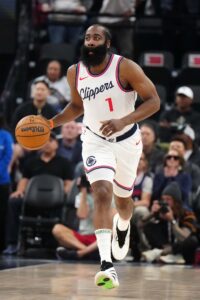
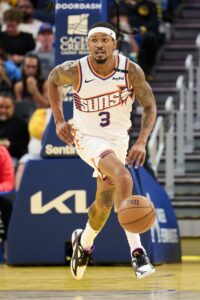 The Clippers made excellent use of their spending flexibility again during the 2025 offseason. While the bi-annual exception wasn’t available again in 2025, the club used every dollar of the non-taxpayer mid-level exception to sign center
The Clippers made excellent use of their spending flexibility again during the 2025 offseason. While the bi-annual exception wasn’t available again in 2025, the club used every dollar of the non-taxpayer mid-level exception to sign center